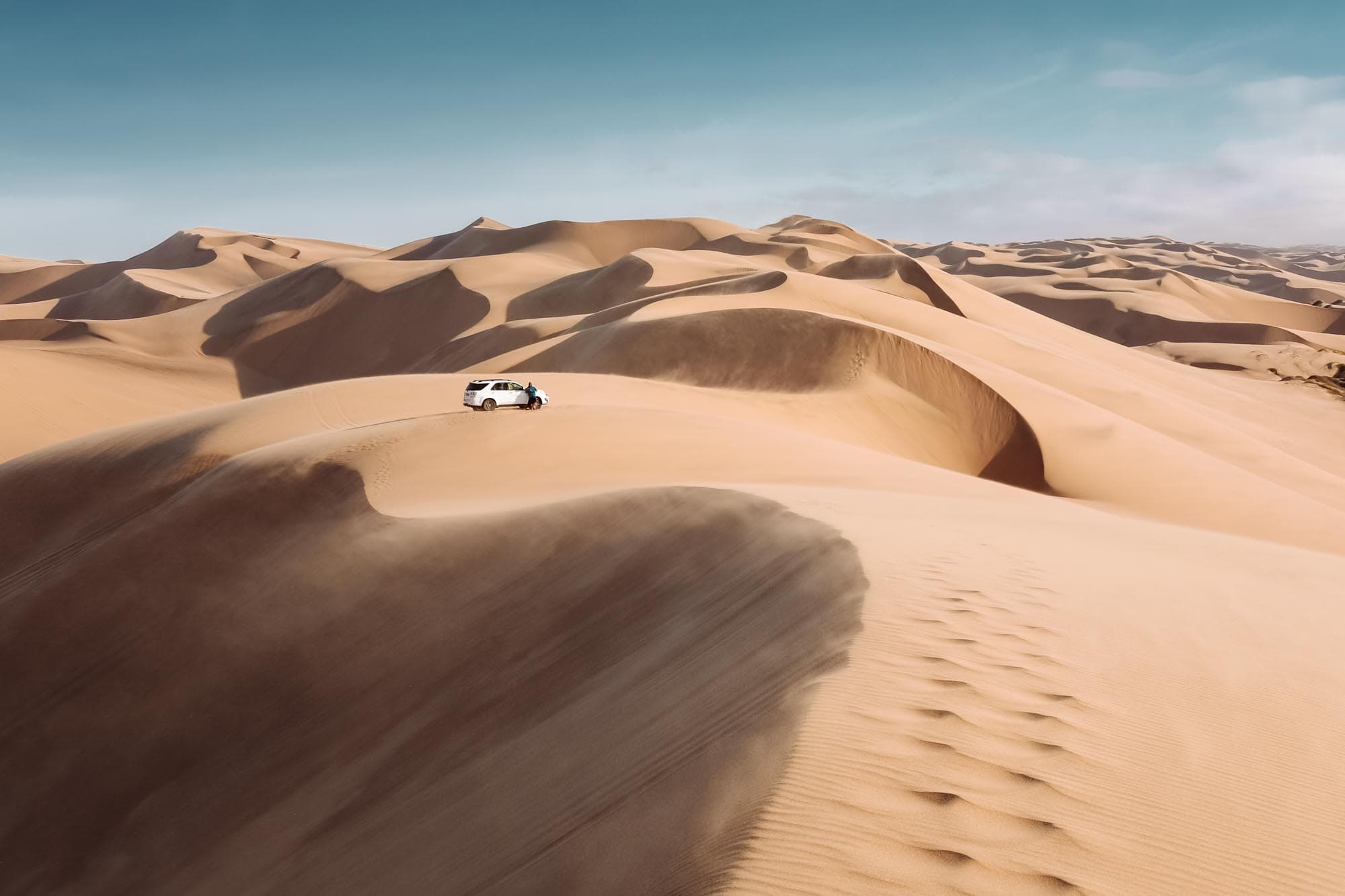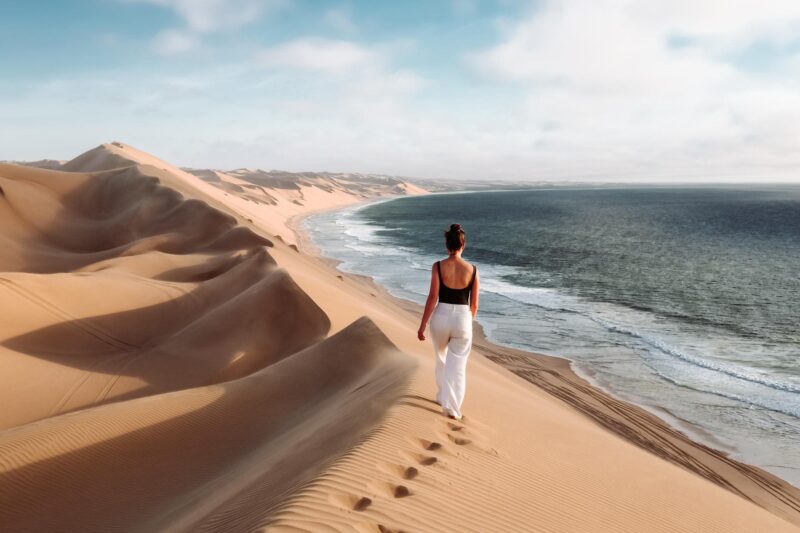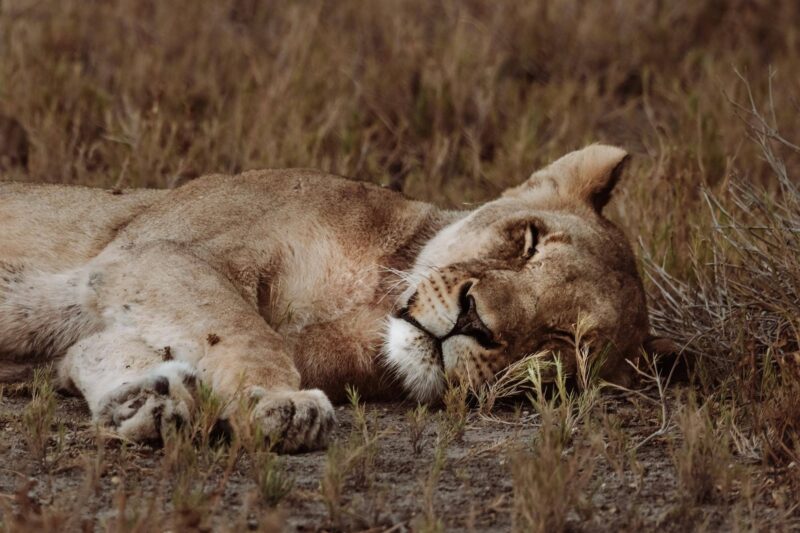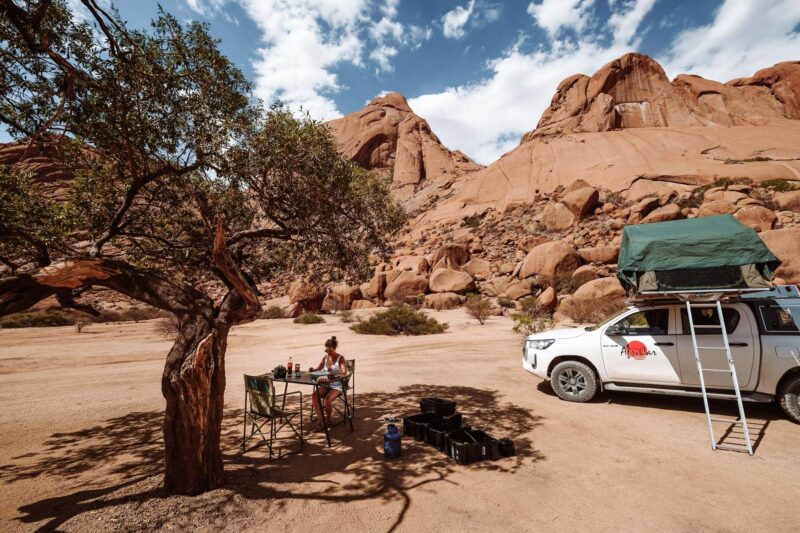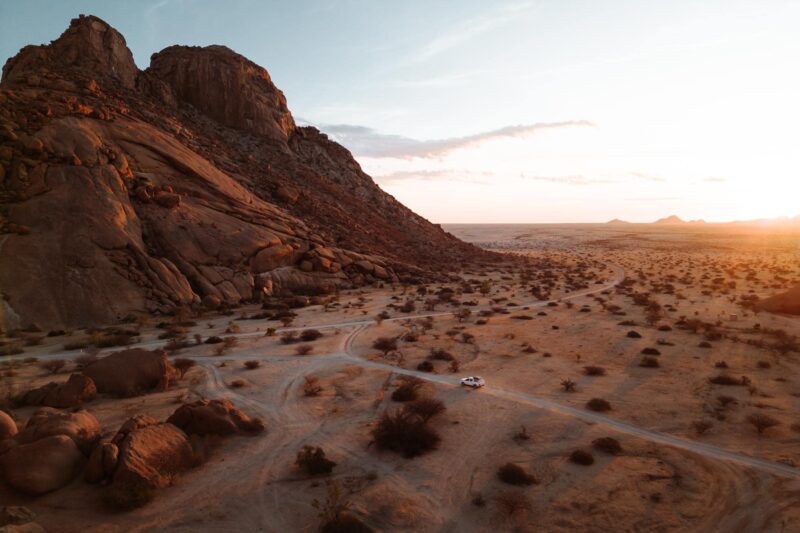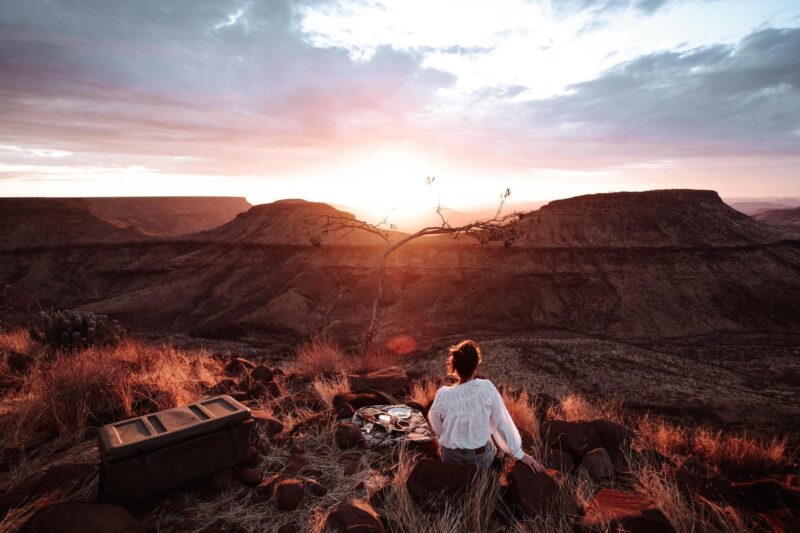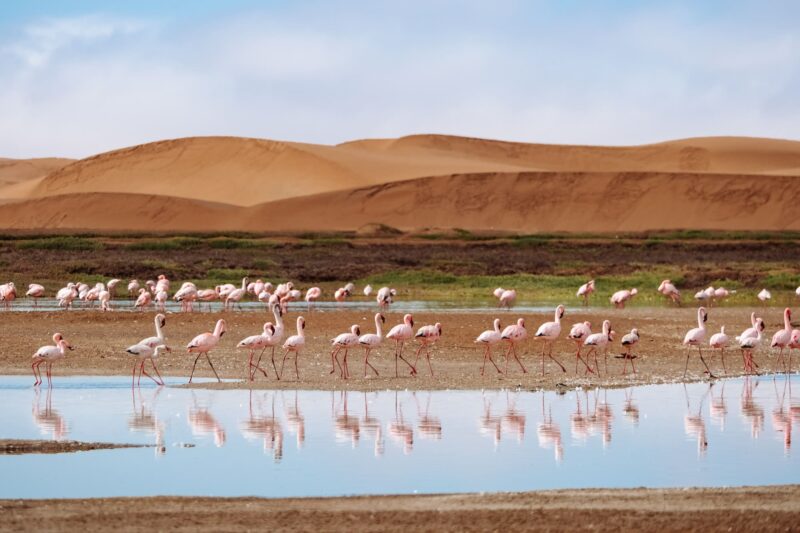Renting a car in Namibia is the ideal way to experience the beauty of the country. The vast landscapes are perfect for an exciting road trip, and with a rental car, you’ll experience the ultimate freedom. Outside the cities, you often encounter so few other road users that it’s customary to give a friendly wave. In Namibia, you’ll have the most beautiful roads almost entirely to yourself! However, these remote landscapes also mean that you need to be properly prepared before setting off. That’s why we’re sharing all the tips for renting a car and driving in Namibia here.

Is renting a car with a roof tent recommended in Namibia?
Nowhere else in the world will you see as many cars with roof tents driving around as in Namibia. This is the perfect destination to embrace this unique way of traveling. With a roof tent, you can camp in the most beautiful spots, and this method of travel is also an affordable alternative to the expensive lodges and hotels in Namibia. We arranged this through Namibia Nomads, and they not only provide a sturdy rental car with a roof tent but also all camping gear, the coolest campsites, and many other practical matters. In our opinion, this is the best way to explore the country and enjoy all the beautiful destinations without worries.
What are the roads like in Namibia?
If you’re planning to travel through Namibia by rental car, you’re probably curious about the condition of the roads there. We’ll let you in on a little secret; you’ll mostly be driving on unpaved roads. Namibia is one of the least densely populated countries in the world, resulting in few paved roads. There’s a total of about 50,000 kilometers (31069 miles) of road network in Namibia. Of these, 6,500 are paved, and 42,500 are unpaved. Fortunately, most unpaved roads are in good condition and offer a much smoother ride than you might expect. The roads are graded and potholes are filled throughout the year. However, there are also roads of lesser quality where you’ll need to drive more slowly. In and around cities like Swakopmund and Windhoek, there are paved roads of good quality.
Is a 4×4 rental car necessary in Namibia?
4×4 and 4WD are abbreviations for four-wheel drive. With a 4×4 rental car, you can drive on almost any terrain and are unlikely to get stuck. You’ll have better visibility as you’re higher up, better grip on unpaved roads, less risk of damaging the underside of the car, and the car can handle steep roads or potholes much better. Since you’ll be driving many kilometers (miles) on unpaved roads, it’s advisable to rent a 4×4 in Namibia. If you visit Namibia during the rainy season (from December to February), a 4×4 is even more essential. Dry riverbeds can flood, and you’ll need a 4×4 to cross them with your car.

Is driving in Namibia safe?
Driving in Namibia is certainly safe. There are few accidents due to the low traffic volume. Apart from the cities, you’ll hardly encounter other road users. However, this is also where the ‘danger’ lies. Danger is a big word, but if your car breaks down, help can be far away. To prepare for this, it’s wise to always have plenty of drinking water in the car. It’s also useful to buy a local SIM card with data and call minutes. You can buy one at the Windhoek airport. While driving, you often won’t have internet, but in most places, there’s coverage to call for help if needed. Do you want to have coverage at all times while driving? Then rent a satellite phone from your rental company. This is only necessary if you’re also going off-road, something most travelers won’t do quickly.
Also, watch out for deep puddles and rivers after heavy rainfall. When there’s a lot of water in potholes, you can’t see how deep they are. Make sure not to cross puddles or rivers if the water is higher than half of your car tire. Be cautious when driving in the mountains as well. Here, you often drive on unpaved roads, making it slippery, and there’s usually no guardrail. Many roads in Namibia are flat and straight for miles. This can be monotonous, so it’s important to always stay alert for signs of fatigue. Additionally, it’s not advisable to drive in the dark. The roads are not lit, and animals are most active at night, increasing the risk of colliding with one. Lastly, it’s wise not to drive too fast on unpaved roads. Loose stones often line the sides of the roads, and hitting them at high speeds can cause you to skid and potentially flip over.
Tips to Reduce the Risk of a Flat Tire
While it’s sometimes unavoidable, you can take action to reduce the risk of getting a flat tire in Namibia.
- Adjust your tire pressure based on the type of road you’re driving on. Maintain a tire pressure of 2.0 bar on paved roads. Lower the pressure to 1.8 bar on gravel roads and to 1.5 bar on sandy roads. Most rental cars come with a tire pressure gauge.
- As the outside temperature rises, so does tire pressure. If you’re leaving from the cool Swakopmund and heading into the hot desert, you’ll likely need to lower your tire pressure.
- If you have a flat tire that you’ve replaced and want to repair it, you can have it done in multiple ways. In that case, contact your rental company and ask them for the best method and which methods are insured. Choosing the wrong method may result in paying for a new tire because the rental company can no longer use it.
Extra tip: Make sure you know how to change a tire. If you don’t know how, watch a tutorial on YouTube.
What to Do When Your Car Breaks Down?
If something breaks on your rental car and you can’t continue driving, it’s frustrating, but there’s no need to stress. It will all work out sooner or later! First and foremost, always call your rental company. It’s important to have their phone number, and make sure your phone is charged. Explain the situation to the rental company, and they’ll arrange a solution for you. If another road user passes by, you can always ask them for help. Almost everyone stops to help each other in Namibia.

Traffic Rules in Namibia
When it comes to traffic rules, a few things may be different from what you’re used to. The biggest difference is that in Namibia, you drive on the left side of the road. It takes some getting used to at first, but you’ll quickly find it normal. It’s advisable to rent an automatic car because otherwise, you’ll also have to shift with your left hand. Additionally, it’s mandatory to drive with your lights on in Namibia. The maximum speed on paved highways is 120 km/h (75 mph), and on unpaved roads, it’s 100 km/h (62 mph). Some rental companies state that you’re not insured if you drive faster than 80 km/h (50 mph) on unpaved roads. Every car has a tracker, so if they mention this, it’s wise to adhere to it. In the event of an accident or damage, they’ll check your speed.
Additional Information and Tips for Renting a Car in Namibia
Below are some useful things to consider when renting a car in Namibia.
International Driver’s License
You need an international driver’s license to rent and drive a car in Namibia. You can apply for one at any ANWB store. Bring a valid driver’s license and a recent passport photo.
We recommend using Google Maps for navigation in Namibia. Download the map of the region where you’ll be driving beforehand, so you can navigate offline. It’s easy to pin the places you’re going to visit so you can quickly access their locations. You can also find gas stations, restaurants, and ATMs offline in Google Maps.
Bring a Credit Card
Bring a credit card in the name of the main driver. This is mandatory for the deposit, and a credit card in another name will not be accepted. You won’t get the rental car if you can’t show a credit card in the main driver’s name or if this credit card doesn’t have enough balance for the deposit. Don’t have a credit card yet? Then we recommend this credit card.
Refueling in Namibia
Because Namibia is so sparsely populated, you’ll also come across few gas stations. It may even be that the next gas station is about 300 kilometers (186 miles) away. Therefore, make sure you always have enough fuel and refuel in time. Often, large 4×4 rental cars in Namibia have two tanks in the car, allowing you to cover extra miles.
Tip: At gas stations in Namibia, an attendant will fill your tank and wash your windows. It’s customary to tip them about 5 to 10 NAD. Make sure the pump is at 0 when the attendant starts refueling.
What Does Renting a Car in Namibia Cost?
The costs for your rental car in Namibia depend on several factors. Consider the season of your travel, how far in advance you book, and the type of car you choose. Additionally, it’s also a matter of whether you want a roof tent or not. A 4×4 without a roof tent and camping gear can be booked starting from $75 per day via Rentalcars.com This includes full insurance. However, you’ll then be tied to the often expensive lodges and restaurants because hotel prices are high in Namibia. Therefore, we opted for a trip with Namibia Nomads. This is one of the most competitively priced providers of trips to Namibia, including a rental car, roof tent, camping gear, campsites, and pick-ups. Both options are enjoyable and have their pros and cons. So, carefully consider what suits you and your budget.
